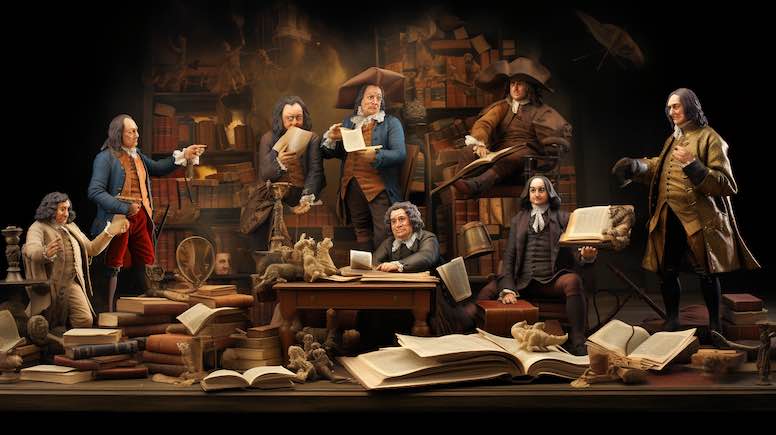Plot summary of the book “Gulliver’s Travels” by Jonathan Swift
“Jonathan Swift‘s “Gulliver’s Travels” is a classic satirical novel that takes readers on a fantastical journey through strange lands and even stranger creatures. Published in 1726, the book follows the adventures of Lemuel Gulliver, a ship surgeon who finds himself shipwrecked multiple times and subsequently discovering new civilizations in each voyage. As he encounters beings ranging from tiny inhabitants of Lilliput to giants in Brobdingnag, Gulliver’s experiences serve as a vehicle for Swift to explore profound themes such as human nature, society, politics, and the flaws of humanity itself.
Overview of “Gulliver’s Travels” by Jonathan Swift
In “Gulliver’s Travels,” Jonathan Swift tells the story of Lemuel Gulliver, a ship’s surgeon who embarks on four extraordinary journeys. The novel is divided into four parts, each detailing Gulliver’s adventures in different lands: Lilliput, Brobdingnag, Laputa/Balnibarbi/Luggnagg/Glubbdubdrib, and the land of the Houyhnhnms.
In Lilliput, Gulliver finds himself in a land inhabited by tiny people only six inches tall. Despite his initial help to the Lilliputians during their war with Blefuscu, he ultimately becomes their enemy due to their petty politics and absurd laws. In contrast, Brobdingnag presents Gulliver with a reverse situation – everything is enormous compared to him. Here he encounters giants who scrutinize his society and expose its flaws through their enlightened perspective.
The following sections take Gulliver to more fantastical places filled with strange inventions and peculiar customs. Laputa portrays an island floating in the sky where intellectuals pursue abstract knowledge but are disconnected from reality. These intellectuals represent Swift’s satirical critique of excessive focus on theoretical sciences without practical application. Lastly, the land of the Houyhnhnms introduces Gulliver to intelligent horses who rule over savage human-like creatures called Yahoos – a commentary on human nature and society as seen through animals’ eyes.
Plot summary: Gulliver’s four extraordinary voyages
In “Gulliver’s Travels” by Jonathan Swift, the protagonist Lemuel Gulliver embarks on four extraordinary voyages that take him to different fictional lands. In his first voyage, Gulliver finds himself shipwrecked and washed ashore in Lilliput, a land inhabited by tiny people. Despite their small size, the Lilliputians are consumed by petty politics and rivalries. Gulliver becomes entangled in their conflicts and eventually escapes when his relations with the Lilliputians sour.
On his second voyage, Gulliver discovers Brobdingnag, a land inhabited by giants who view him as nothing more than a curiosity. In this giant world, Gulliver is exposed to various forms of physical and moral degradation. He soon realizes that size does not equate to wisdom or virtue as he encounters both ignorance and kindness among these giants.
Gulliver’s third voyage leads him to Laputa, an island floating in the sky populated by intellectuals obsessed with abstract thinking but lacking practical skills. Here, Swift satirizes the absurdity of excessive intellectualism divorced from real-world application. Lastly, in his fourth voyage to Houyhnhnm Land, Gulliver encounters rational horses known as Houyhnhnms who govern a society where humans called Yahoos live like wild beasts. This encounter forces Gulliver to critically reflect on human nature and question whether humans are truly superior beings.
Themes: Satire, human nature, and colonialism
In Jonathan Swift’s “Gulliver’s Travels,” the author employs satire to critique various aspects of human nature and colonialism. The novel is divided into four parts, each presenting a different voyage of the protagonist Lemuel Gulliver. Through his encounters with the Lilliputians, Brobdingnagians, Laputans, and Houyhnhnms, Swift satirizes different societies and their flaws.
One of the key themes explored in “Gulliver’s Travels” is the flawed nature of mankind. In the first part, Gulliver finds himself in Lilliput, where he witnesses absurd political conflicts over trivial matters. This satirical portrayal highlights humanity’s tendency to prioritize personal interests over collective harmony. Similarly, in his journey to Brobdingnag, Gulliver encounters giants who expose our inherent weaknesses and vices when magnified on a larger scale. Swift uses this exaggerated depiction to criticize human vanity and pretentiousness.
Another significant theme addressed by Swift is colonialism and its destructive effects on both colonizers and colonized peoples. In Book III, Gulliver visits Laputa – a floating island inhabited by intellectuals who are detached from reality but obsessed with abstract theories. Here, Swift comments on European colonization by highlighting how it often prioritizes intellectual pursuits at the expense of practical progress or empathy towards others’ suffering.
Social critique: Swift’s commentary on society
In Jonathan Swift’s “Gulliver’s Travels,” the protagonist, Lemuel Gulliver, embarks on four extraordinary voyages that take him to strange and fantastical lands. Through these travels, Swift provides a scathing critique of the society he lived in during the early 18th century. One key theme explored in the book is the absurdity of human arrogance and pride. In Lilliput, Gulliver encounters a kingdom where the rival factions engage in petty disagreements over trivial matters such as which end of an egg should be cracked first. This satirical portrayal highlights how individuals can become so consumed by their own egos and self-importance that they lose sight of more significant issues.
Another theme examined is Swift’s criticism of political corruption and manipulation. In Brobdingnag, Gulliver finds himself in a land inhabited by giants who view him as nothing more than an entertaining curiosity. Here, Swift exposes the flaws within human institutions by contrasting Gulliver’s experiences with those of his giant hosts. The giants are honest, reasonable beings who value truth and justice above all else – characteristics sorely lacking in Gulliver’s own society back home.
Overall, “Gulliver’s Travels” serves as a powerful social critique that tackles various aspects of humanity such as pride, greed, corruption, and irrationality.
Exploration of other cultures and civilizations
In Jonathan Swift’s “Gulliver’s Travels,” the protagonist, Lemuel Gulliver, embarks on a series of extraordinary journeys that take him to various far-flung lands and introduce him to diverse cultures and civilizations. Through his encounters with these societies, Gulliver offers readers a satirical critique of human nature and society at large.
One of the key themes explored in the book is the inherent flaws and follies of humanity. In his travels, Gulliver encounters different societies that represent exaggerated versions of certain aspects of human behavior. Whether it is the rational but emotionless Houyhnhnms or the savage Yahoos who embody base instincts, each civilization serves as a critique on specific human traits or societal structures.
Another significant theme in “Gulliver’s Travels” is cultural relativism. As Gulliver navigates through these new lands and interacts with their inhabitants, he learns about their customs, beliefs, and traditions. This exploration fosters empathy within him as he realizes that what may seem strange or barbaric to one culture can be perfectly normal for another. Swift uses this theme to prompt readers to question their own cultural biases and prejudices.
Through its exploration of other cultures and civilizations, “Gulliver’s Travels” provides readers with an opportunity to reflect on their own society while also challenging conventional norms and values.

Political allegory: Representations of real-world events
In the book “Gulliver’s Travels” by Jonathan Swift, political allegory is a prominent feature. The story follows Lemuel Gulliver, an English surgeon and ship captain who embarks on various journeys to different fantastical lands. Through his encounters with strange societies such as Lilliput, Brobdingnag, Laputa, and Houyhnhnm, Swift uses these fictional settings to satirize and comment on real-world events and political systems.
One of the key themes in “Gulliver’s Travels” is the critique of government corruption. In Lilliput, for example, Gulliver witnesses the absurdity of political power struggles as he becomes entangled in a conflict between two factions over which end of an egg should be cracked first. This satire parallels the petty disputes among politicians in Swift’s time and highlights their triviality compared to pressing societal issues.
Another significant theme in the book is imperialism and colonialism. In his travels to places like Brobdingnag and Laputa, Gulliver encounters societies that reflect different aspects of European colonization efforts during Swift’s era. These societies serve as metaphors for England’s exploitation of other nations for resources or labor. For instance, Brobdingnag exposes the flaws of European imperialism through its giant inhabitants’ disgust at Gulliver’s tales of war and conquest.
Conclusion: Impact and enduring relevance of the book
In conclusion, the impact of “Gulliver’s Travels” by Jonathan Swift cannot be overstated. The book has had a lasting effect on literature and popular culture since its publication in 1726. Its satirical portrayal of human nature and society continues to resonate with readers today.
One enduring relevance of the book is its exploration of power dynamics and political satire. Through Gulliver’s various encounters with different societies, Swift critiques the corruption and hypocrisy of governments. This critique remains relevant in contemporary times as readers can still draw parallels between the fictional societies in the book and real-world political systems.
Furthermore, “Gulliver’s Travels” has become a cultural touchstone, with many elements from the book becoming ingrained in popular culture. The term “Lilliputian,” for example, is now commonly used to describe something small or insignificant. Additionally, Gulliver’s journey to Brobdingnag, where he encounters giants, has been referenced and parodied countless times in films, television shows, and other works of literature.
In summary, “Gulliver’s Travels” continues to have a significant impact due to its exploration of power dynamics and its enduring presence in popular culture. Jonathan Swift’s satirical masterpiece remains an important work that offers insightful commentary on human nature and society even after centuries since its publication.












